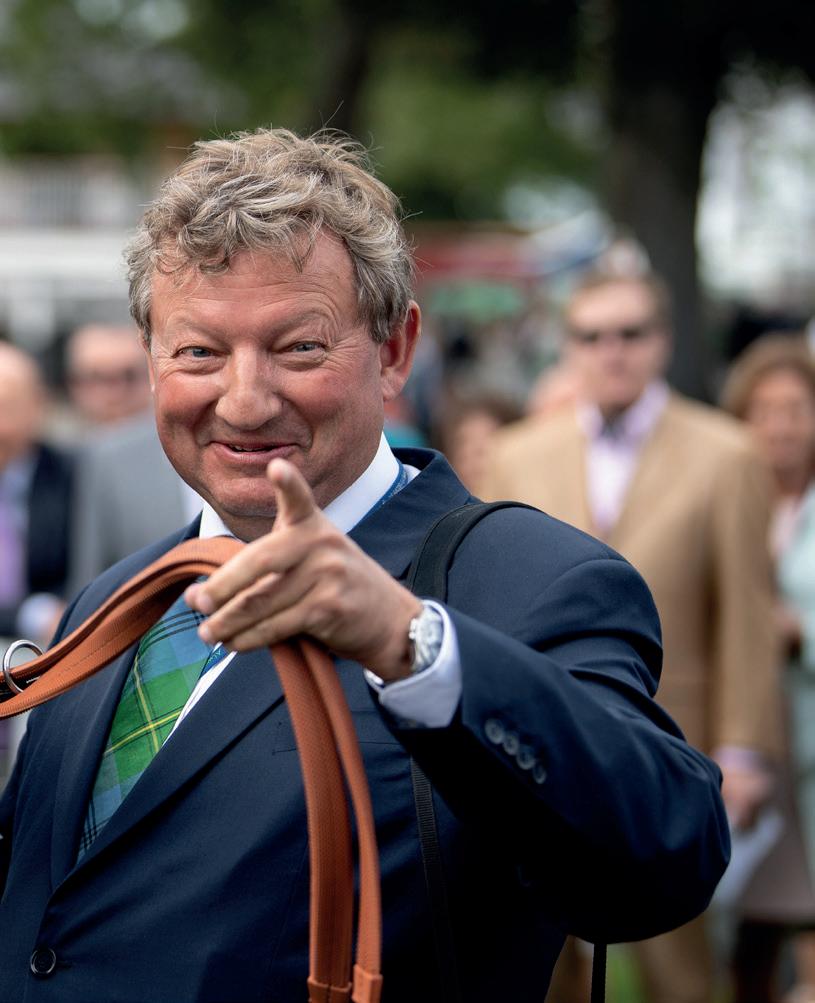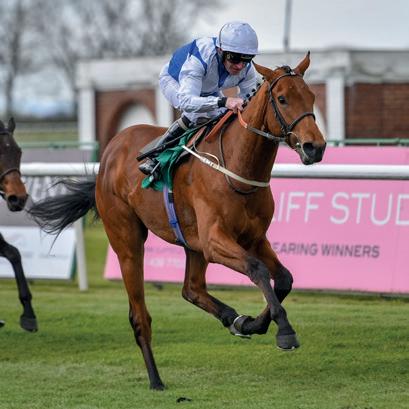
6 minute read
Attention to detail
to detail ATTENTION
Trainer Mark Johnston has enjoyed huge success buying at Tattersalls for thirty years but, as he explains to Tom Peacock, there is no secret recipe

Bijou D'Inde

Just as a top Chief Executive should be familiar with every level of their business from the factory floor to the boardroom, thoroughness is the abiding quality in the regime of Mark Johnston.
Not content with managing the exercise and racing fortunes of several hundred Thoroughbreds based around his stable in Middleham, Johnston also selects the vast majority of the next generation himself. And if that was not enough, he is also a qualified vet.
Attention to detail explains just why the Scotsman has worked his way from ramshackle premises in Lincolnshire in the late 1980s to last year becoming the all-time record-holding British trainer with his 4,194th winner. Just 58 at the time, it is hard to envisage quite how far he will stand clear once he is finished.
Although he has landed the Tattersalls Book 1 Bonuses with regularity, you will see Johnston at every tier of events at Park Paddocks, iPad in hand, bidding from six figures down to even four.
“It’s probably the best part of the job,” he says without hesitation. “It’s the whole process. I remember discussing it with (wife) Deirdre maybe 20 years ago, saying that no matter how big we get, we must keep buying these five-grand horses, just to test ourselves. I still love doing it.”
Johnston believes the first time he went scouting at Tattersalls was at the end of 1986 with Paul Venner, the owner of Baileys Horse Feeds. Six years later Venner would entrust him with another October Yearling Sale graduate in Mister Baileys, supplier of the trainer’s first Classic winner in the 2,000 Guineas.

“I think Paul bought a Sharpo filly which he was going to send to me,” he recalls. “But I was the new kid on the block and he sent him to Gerry Blum instead and sent me a different one.”
Even though he was operating with considerably more meagre resources, and has another 30 years of experience under his belt, what is most unusual is that he has retained almost exactly the same buying regimen.
“I think I’ve always had similar criteria,” he says. “I was already very into the idea that you should buy on pedigree, and that pedigree means performance by the dam, and not those from the time of Henry VIII! It moved very quickly into exactly the same system that we use today, although I’m now looking for dams of progeny rated over 90, whereas in those days it was probably 10lbs lower.”
“If I’m more critical, I probably looked a little bit more at second dams then than I do now. The dam’s got to have done it, it doesn’t matter if she’s a half-sister to Australia, if she’s not done it herself, that’s not good enough for me.”
A man who ploughs his own furrow in terms of training, and indeed his views on the sport itself, he is similarly phlegmatic on looking at the physical specimen at a sale.
“I’m forgiving, but I’m just logical,” he says. “Which way they turn their toes hasn’t got a great bearing on either their soundness or their ability, and I knew that from a very early stage. I think I’ve probably got more confident in my theories than I was then, but they are the same theories.” Charlie Johnston


Xcelente


“The Newmarket Equine Hospital sent out something a couple of years ago saying that if these common conformational faults as we call them, if they had a bearing on soundness or ability we would have bred it out of the Thoroughbred. We haven’t done that, which quite clearly shows they don’t. That was fairly obvious to me - the old Tesio theory of that the Thoroughbred was bred on a piece of wood.”
Johnston has assistance from his team for a primary dissection of each catalogue and compares notes with his son Charlie. However, ever since the days of picking up the likes of St James’s Palace winner Bijou D’Inde for 20,000 gns, it is ultimately his call.
“I’m spending my own money, I’d say way, way over 90 per cent of the horses I buy are bought on spec,” he explains. “It’s very rare for me to have a firm order or for the horse to be allocated, it’s always been my own risk. That’s a good thing and a bad thing - obviously it greatly limits what you can afford to spend, but at the same time it focuses you on getting value for money, and also means that I’m not restricted to having to justify why I bought it to the same extent.”
Some of Kingsley House’s best recent alumni have been Book 1 Bonus winners, although they tend not to have been as costly as Elarqam, the 1,600,000 gns son of Frankel and Johnston’s 1,000 Guineas heroine Attraction, who was sent to him by Sheikh Hamdan Al Maktoum. Main Edition, his Royal Ascot and German Guineas scorer, cost 62,000 gns, while Nyaleti, who took the Dusseldorf Classic 12 months earlier, was just 40,000 gns.
“I love buying in Book 1 because 75-80 per cent of them will fit my pedigree criteria,” he says. “It’s a case of scoring out the absolute no-hopers you couldn’t touch on conformation, and they’re few and far between because they have been weeded out by the Tattersalls selection process. You could be looking for soundness issues, but beyond that it’s just a case of standing in the ring and buying the cheapest.”
“Sometimes it’s a bit frustrating because the ones you really want you can’t afford, but it’s expected because everything has got a good pedigree. The Book 1 Bonus has made a big difference and we got a great kick out of Xcelente this year. We paid 62 for him and almost got two-thirds of it back on his first run. Misty Grey was another, he cost 72 and got to Royal Ascot. It works very well because of the end of the market we’re operating at.”
Johnston chuckles when it is suggested that his end of the market is still different to what it was in 1986. “A little bit. But considering I bought one last year for 1,000 gns, things haven’t changed too much.”













